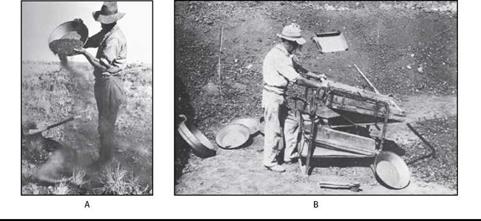The classification of very fine particles is carried out in many industries in air rather than water to avoid problems with chemical reactions of particles with water and with separation of ultrafine particles from water and drying them. Some of the disadvantages of dry classification are that it requires ducts and processing equipment that are capable of handling large volumes of air, so care must be taken to clean the air leaving the process to prevent particles from escaping into the atmosphere. Air classification has been used for thousands of years to remove waste from cereal grains and to concentrate fine particles of gold (see Figure 9.7 for an early application). It is now used in many industries to process thousands of millions of tons of solid particles annually. Cement and coal are the high-tonnage processes.
Air classification became important in the latter part of the 19th century when tube mills were developed to produce large volumes of portland cement, which had become a significant building material. The grinding process highlighted the need for efficient separation of ultrafine particles from the mill discharge, and screens proved to be inadequate. Mumford and Moodie patented the Askham separator in 1885 to classify very fine particles by air, and 4 years later Gebruder, which built cement manufacturing plants, improved the Askham separator and marketed it.
These machines had rotating parts for material and airflow distribution to improve the efficiency of separation. Its principle of operation is still used in modern air classifiers, or air separators as they are more commonly called. The Askham units were the first generation of dynamic air separators, and we will discuss their evolution over 100 years
|
FIGURE 9.7 (a) Miner in the 1930s using the wind to separate gold from ore after pulverizing (b) foot-operated air blower used for separation (Stone and MacKinnon 1976) |
into second — and third-generation separators, during which time the rejection of coarse particles was improved and the bypass was minimized.
Another type of unit is the static air separator, which has no moving parts; the conveying air medium performs the separation by changes in air velocity and direction. The different types of separators will be discussed in this chapter. The change in separator designs had the objectives of better performance by
■ Improving the precision of separation (eliminating misplaced particles)
■ Reducing the amount of feed bypassing to the coarse product
This gives some control over the split size d50 and the width of the particle-size distribution, which is represented by its slope on a Rosin-Rammler-Bennett line (its sharpness). Table 9.1 shows the gradual improvement that has been achieved as air separators have been improved.

